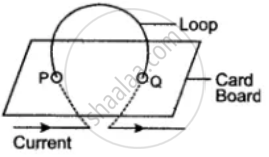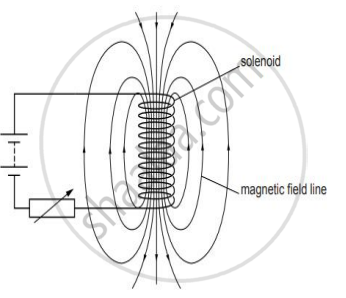Advertisements
Advertisements
Question
Derive the expression for the heat produced due to a current ‘I’ flowing for a time interval ‘t’ through a resistor ‘R’ having a potential difference ‘V’ across its ends. With which name is the relation known? How much heat will an instrument of 12W produce in one minute if it is connected to a battery of 12V?
Solution
Consider a resistor of resistance R. Let the current flowing through this resistor be I and the potential difference across it be V.
In time t, let Q amount of charge flows through the resistor.
Work done on moving this charge, W = VQ ... (1)
According to the definition of electric current,
`1=Q/t`
Q = I × t
Putting this in equation (1),
W = V × I × t
This work done is dissipated as heat.
Hence,
Heat produced, H = W = VIt
H = VIt ... (2)
According to Ohm’s law, V = IR.
Putting this in equation (2),
H = IR × It
H = I2Rt
This relation is known as Joule’s law of heating.
Power, P = 12 W
Potential difference, V =12 V
Time duration of current flow, t = 1 min = 60 s
`P = H/t`
H = P × t
= 12 W × 60 s
= 720 J
The heat generated by the instrument of 12 W in a minute is 720 J.
APPEARS IN
RELATED QUESTIONS
State the direction in which current-carrying freely suspended solenoid rests
Why does a current carrying freely suspended solenoid rest along a particular direction? State the direction in which it rests.
- What name is given to a cylindrical coil of diameter less than its length?
- If a piece of soft iron is placed inside the coil mentioned in part (a) and current is passed in the coil from a battery, what name is then given to the device so obtained?
- Give one use of the device mentioned in part (b).
What is a solenoid?
The diagram shows a current-carrying coil passing through a cardboard sheet. Draw three magnetic lines of force on the board.

State two factors on which magnitude of magnetic field at the centre depends.
The adjacent diagram shows a small magnet placed near a solenoid. State whether the magnet is attracted or repelled, as the switch is pressed. Give a reason.
What is a solenoid? Why do we usually keep its diameter small in comparison to its length?
What does the divergence of magnetic field lines near the ends of a current carrying straight solenoid indicate?
Ansari Sir was demonstrating an experiment in his class with the setup as shown in the figure below.

A magnet is attached to a spring. The magnet can go in and out of the stationary coil. He lifted the Magnet and released it to make it oscillate through the coil.
Based on your understanding of the phenomenon, answer the following question.
Is there any difference in the observations in the galvanometer when the Magnet swings in and then out of the stationary coil? Justify your answer.
Refer to the image below and state how the magnetic field pattern indicates regions where the magnetic field is stronger outside the magnet. What happens to the magnetic field when the current in the circuit is reversed?

